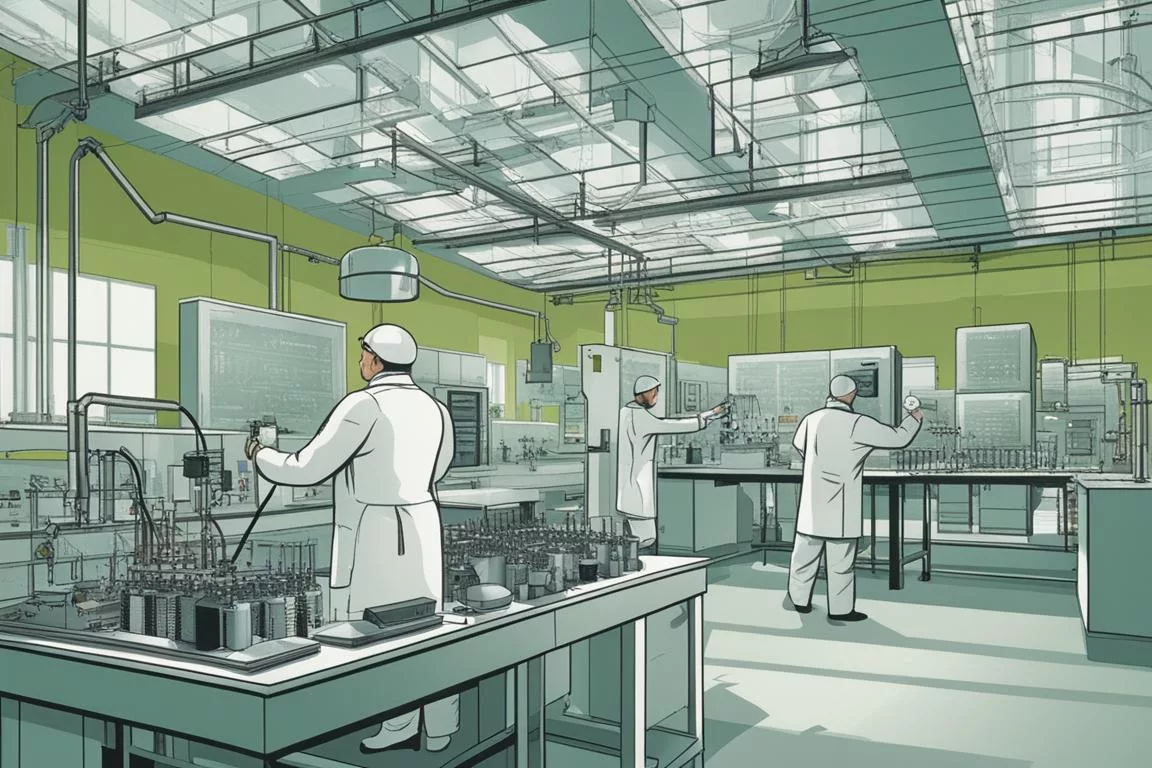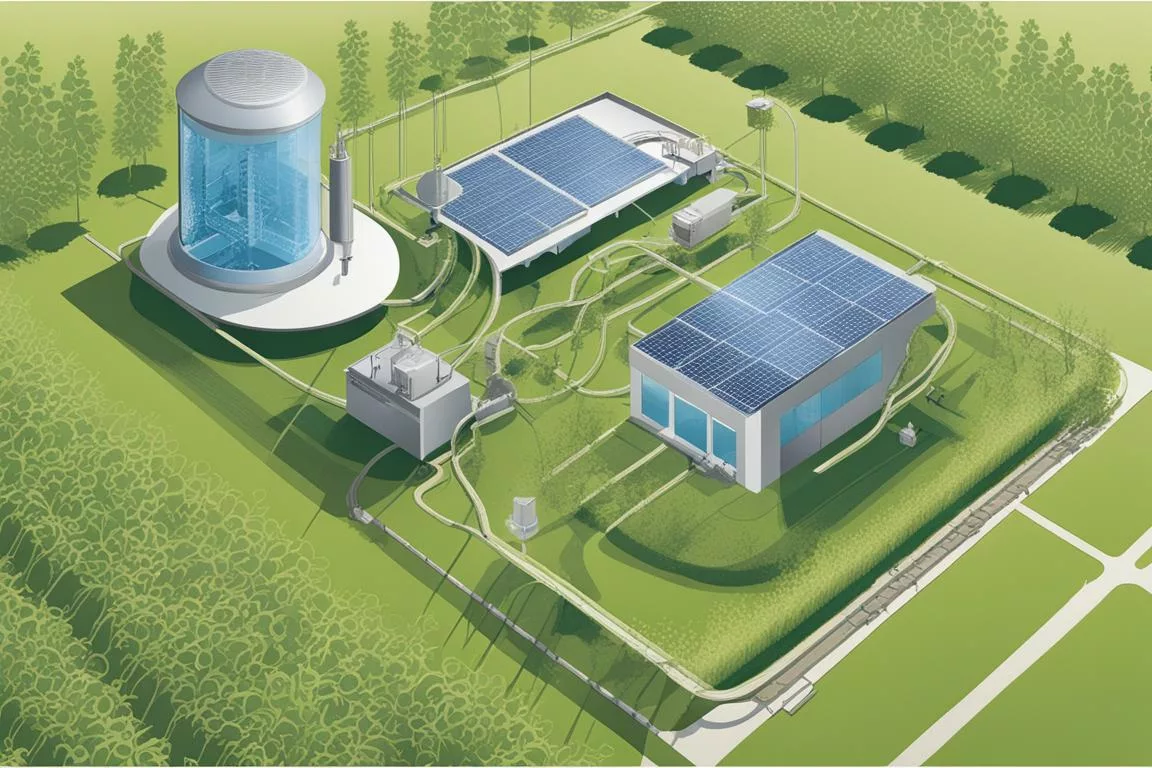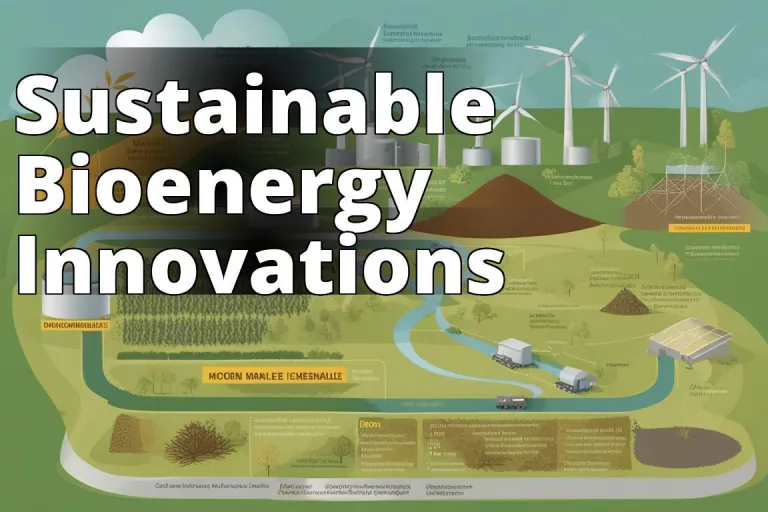Bioenergy technologies, including biofuels, bioproducts, and energy derived from organic materials, are at the forefront of revolutionizing climate change solutions. In today’s world, where environmental conservation and sustainable energy sources are crucial, bioenergy technologies offer a promising pathway towards a greener future. This article delves into the multifaceted domain of bioenergy technologies, exploring their significance, production processes, environmental and economic benefits, research and development initiatives, policy landscape, success stories, challenges, future outlook, integration with other renewable energy sources, community engagement, and the overall role of bioenergy technologies in combatting climate change.
What You Will Learn About Bioenergy Technologies
By reading this article, you will learn:
- The definition and significance of bioenergy, its role in addressing climate change, and the importance of sustainable and renewable energy sources.
- Overview of bioenergy production processes, environmental and economic benefits, research and development initiatives, policy, regulation, international agreements, case studies, challenges, and technological advancements.
- The integration of bioenergy with other renewable energy sources, community engagement, education, public awareness, and the practical applications and environmental benefits of bioenergy technologies.

What is Bioenergy?
Bioenergy, also known as biological energy, is a form of renewable energy derived from biological sources such as organic materials, biomass, and waste products. It involves the conversion of biological materials, such as crops, forestry residues, and agricultural waste, into heat, electricity, or fuel. Bioenergy has gained popularity as it provides a sustainable alternative to fossil fuels and offers numerous advantages. It can be stored with little energy loss, emits little or no greenhouse gas emissions, and is considered carbon neutral, as the carbon released during combustion is reabsorbed by the next crop of plants. Bioenergy can be produced from a variety of biomass sources, including animal and plant materials, agriculture, algae, and industrial waste.
Bioenergy Feedstock
The most commonly used bioenergy feedstocks in the United States include:
- Corn: Corn is a significant feedstock for bioenergy production, particularly in the production of ethanol, which is a key biofuel in the U.S. Ethanol is primarily made from corn and is an important component of the country’s fuel consumption, especially in the transport sector.
- Soybean Oil: Soybean oil is a primary input for the production of biodiesel and renewable diesel, making it a crucial bioenergy feedstock in the U.S.
- Vegetable Oils and Animal Fats: Other vegetable oils, animal fats, waste oils, and greases are also commonly used feedstocks for the production of biodiesel and renewable diesel in the United States.
- Agricultural Residues: Residues from agricultural activities, such as corn stover, are utilized as bioenergy feedstocks.
- Dedicated Energy Crops: Certain dedicated energy crops like switchgrass, miscanthus, energy cane, sweet sorghum, high biomass sorghum, hybrid poplars, and shrub willows are being increasingly explored as bioenergy feedstocks.
- Forestry Residues: Residues from forestry activities, including logging residues and forest thinning, are also used as bioenergy feedstocks.
- Algae: Algal biomass is another potential feedstock for bioenergy production in the U.S.
These feedstocks are utilized in the production of biofuels and other bioenergy applications, contributing to the renewable energy sector in the United States.
Bioenergy Production Processes
Bioenergy can be produced through various processes, including photobiological fermentation, anaerobic digestion, enzymatic processes, and microbial electrolysis. These processes utilize different technologies to convert organic materials into energy, offering a wide range of options for bioenergy production.
Photobiological Fermentation
Photobiological fermentation, specifically photofermentation, is a biological process that utilizes light as an energy source for the fermentation of organic compounds. This process is predominantly found in photosynthetic bacteria such as green sulfur bacteria, purple non-sulfur bacteria, and purple sulfur bacteria. Unlike traditional fermentation processes that rely on the breakdown of organic compounds to produce energy, photofermentation harnesses light energy to drive the fermentation of organic substrates, resulting in the production of bioenergy products such as biohydrogen. Photobiological fermentation has several advantages. It utilizes a renewable energy source, light, and can produce various types of biofuels. Additionally, it is associated with low greenhouse gas emissions. However, this process also has its drawbacks. It often requires high capital and operating costs, and its efficiency can be affected by the availability of light. Furthermore, the technical complexity of this method can pose challenges.
Anaerobic Digestion
Anaerobic digestion (AD) is a way of turning plant or animal waste into gas by using tiny living things that do not need air. The gas has a lot of methane, which can be used to make heat, electricity, or both. Many farmers use AD to make biogas from their waste and use it to warm their buildings. The waste can come from sewage, animal manure, or garbage. An AD plant has a big tank where the waste goes, and some machines that help make and store the gas. The tank is closed and has different shapes and sizes depending on the place and the waste. The tank has many kinds of tiny living things that eat the waste and make biogas. The biogas has methane and other gases that can be burned like natural gas. The biogas can be used for many things, such as heating, making electricity, or cooling. The leftover waste is like fertilizer without the smell, and can be used to help plants grow. AD is a safe way of turning waste into gas in big round tanks. The waste does not burn, so nothing bad goes into the air. AD is a good way of using waste naturally without air, and it makes clean gas and useful fertilizer. AD is good for the environment and people, because it gets rid of extra waste that can cause problems if not handled well. Anaerobic digestion offers effective waste management, as it can convert organic waste into biogas for various applications, while also reducing greenhouse gas emissions. However, photobiological fermentation has some limitations, such as the requirement for specific waste feedstock, long processing time, and the potential for process instability.
Enzymatic Processes
Enzymatic processes, also known as enzymatic hydrolysis, involve the use of enzymes to break down complex organic materials, such as lignocellulosic biomass, into simple sugars that can be fermented to produce biofuels, particularly bioethanol. This method is a key step in the conversion of biomass into bioenergy products and is an important part of the production of second-generation biofuels.
Enzymatic hydrolysis is a critical process in the conversion of cellulose and hemicellulose, which are the major components of lignocellulosic biomass, into fermentable sugars. This process typically involves the use of enzymes such as cellulases, hemicellulases, and pectinases to catalyze the breakdown of complex polysaccharides into monomeric sugars, such as glucose and xylose, which can then be fermented into bioethanol.
The use of enzymes in biofuels production offers several advantages. It allows for the use of a wide range of feedstocks, including agricultural residues, wood feedstocks, and other lignocellulosic biomass, which are not in competition with food production. Enzymatic processes are also less energy-intensive and more environmentally friendly compared to traditional methods, and they enable the use of unrefined feedstocks, including waste materials, without the need for extensive pretreatment.
Research in this field aims to improve the efficiency and reduce the negative environmental impacts of bioenergy production processes. Ongoing efforts are focused on developing new and more effective enzymes to ensure a more cost-effective and sustainable process. Additionally, innovative protein and enzyme engineering processes are being explored to enhance the performance and stability of enzymes used in bioenergy production.
Enzymatic processes are known for their high specificity and efficiency in converting biomass into biofuels. Enzymatic processes can utilize a variety of biomass sources and operate at lower temperatures. On the downside, the production of enzymes can be costly, and these processes are sensitive to factors such as pH and temperature, leading to long processing times.
Microbial Electrolysis
Microbial electrolysis is a bioelectrochemical process that involves the use of microorganisms to produce hydrogen or other value-added compounds from organic matter or wastewater. This process takes place in a microbial electrolysis cell (MEC), which is an environmentally friendly technology that can be used for hydrogen production and simultaneous wastewater treatment. The MEC operates through anodic bio-catalytic oxidation and cathodic reduction processes, and it requires an external energy input, making it a less sustainable option compared to some other bioenergy technologies. However, the MEC has shown potential for sustainable bio-hydrogen production and has attracted significant attention in both academia and industry.
Research has demonstrated that microbial electrolysis cells (MECs) have significant potential for biohydrogen production along with wastewater treatment. They have been shown to be effective in generating biohydrogen from various organic substrates, such as acetate, butyrate, and propionate, at relatively low energy consumption. Additionally, MECs have been explored for their ability to increase anaerobic acidogenesis by processing sulfate-containing wastewater and achieving better sulfate removal.
The use of MECs for bio-hydrogen production is considered a significantly sustainable bio-electrochemical system. While the technology requires an external energy input, it has shown promise for the production of bio-hydrogen and other value-added compounds from organic matter and wastewater. Ongoing research and development efforts are focused on optimizing MECs for efficient bio-hydrogen production and their potential for large-scale application in the field of bioenergy.
Microbial electrolysis has the advantage of producing high-purity hydrogen with minimal carbon emissions. It can also utilize a variety of organic feedstocks. However, this process requires high energy input, is sensitive to feedstock composition, and can be technically challenging to implement.
Environmental and Economic Benefits of Bioenergy
Reducing Greenhouse Gas Emissions through Bioenergy
Bioenergy technologies significantly contribute to reducing greenhouse gas emissions by providing a renewable alternative to fossil fuels. Studies have shown that biofuels and bioproducts derived from biomass result in lower carbon emissions, thereby mitigating the adverse effects of climate change.
Sustainable Land Use Practices for Bioenergy Production
The cultivation of energy crops and sustainable forest management for bioenergy production promotes environmentally friendly land use practices. By utilizing marginal lands and agricultural residues, bioenergy technologies facilitate sustainable resource utilization without encroaching on food production.
Job Creation, Energy Security, and Reduced Reliance on Fossil Fuels
The adoption of bioenergy technologies fosters job creation in rural and urban areas, strengthens energy security, and reduces the dependence on finite fossil fuel reserves. These economic benefits contribute to a more resilient and sustainable energy landscape.

Research and Development Initiatives in Bioenergy Technologies
Many countries have research and development initiatives in Bioenergy technologies. Here is a list of some examples:
- Biomass Research and Development (BR&D) Board: The BR&D Board coordinates research and development activities concerning bio-based fuels, products, and power across various federal government agencies. It oversees the interagency Bioeconomy Initiative, a coordinated federal effort to expand the sustainable use of the nation’s abundant biomass for bioproducts and biopower.
- Biomass Research and Development Initiative (BRDI): This program has awarded research, development, and demonstration projects on biobased products, bioenergy, biofuels, biopower, and related processes.
- U.S. National Renewable Energy Laboratory (NREL): NREL is actively engaged in bioenergy research and development activities to advance the technologies for producing bio-based energy, fuels, and products. Their work supports the U.S. Department of Energy’s Bioenergy Technologies Office and the Office of Science.
- Bioenergy Sustaining the Future (BESTF) 3 (BESTF3): This initiative, funded under the Horizon 2020 Framework Programme for Research and Innovation of the European Commission, aims to promote the development of bioenergy technologies across Europe.
- OECD Initiative: The OECD has initiatives focused on improving competition, innovation, and finance for bioenergy. These initiatives support technology research, development, demonstration, and deployment across the European Union.
- European Biomass Industry Association (EUBIA): The EUBIA emphasizes that research and development are key to enabling the transition to a circular economy and boosting the competitiveness of EU industry.
- Bioenergy Innovation in Colombia: There are initiatives in Colombia aimed at increasing investment in innovation to improve the business case for bioenergy projects. These initiatives focus on developing cost-effective solutions adapted to the specific needs or context of local applications, such as biodigesters for small-scale applications and domestic pellet production using lignocellulosic waste from industry and agriculture.
These initiatives reflect the global focus on advancing bioenergy technologies through research, innovation, and collaborative efforts across different regions.
Case Study: Bioenergy Carbon Capture and Storage
A study published in Climatic Change emphasizes the large-scale deployment of bioenergy as a key long-term option to reduce CO2 emissions. The study highlights the importance of bioenergy in the context of deep emission reductions, particularly due to its potential to substitute for fossil fuels. The scenario analysis indicates that the use of bioenergy can lead to a significant decrease in emissions, particularly when coupled with carbon pricing measures. The study also underscores the role of advanced bioenergy technologies and the deployment of Bioenergy Carbon Capture and Storage (BECCS) in achieving net-negative emissions.
Bioenergy with Carbon Capture and Storage (BECCS) is a carbon removal technique that involves two primary technologies. Biomass, which is organic material, is first converted into heat, electricity, or liquid or gas fuels (the “bioenergy” step). Subsequently, the carbon emissions from this bioenergy conversion are captured and stored in geological formations, thereby removing carbon dioxide (CO2) from the atmosphere. BECCS can be considered a “negative emissions technology” when implemented effectively, as it has the potential to draw down the concentration of CO2 in the atmosphere. However, it is essential to ensure that emissions from the growing, harvesting, transporting, and processing of the biomass do not outweigh the captured carbon, and that the storage of captured carbon is reliable over long timescales. BECCS offers co-benefits such as energy production, including carbon-negative fuels for hard-to-decarbonize sectors, but it also raises concerns related to land use, air pollution, and geologic storage. The technology is being incentivized through various policy measures to address barriers and support its deployment in different applications, such as bioethanol, power, and industry. BECCS is recognized as one of the most scalable negative emissions technologies available today, with ongoing pilot projects and partnerships aimed at its development and deployment.
Incentivizing BioEnergy Carbon Capture and Storage (BECCS) has been a subject of policy discussions, as it can serve to offset residual emissions in hard-to-abate sectors and contribute to net-negative emissions on a global level. Policy instruments and incentives play a crucial role in promoting the deployment of BECCS and other bio-CCS initiatives, thereby facilitating substantial carbon emission reductions.
Furthermore, the deployment of bioenergy with carbon capture and storage (bio-CCS) has been identified as a significant approach to achieving carbon emission reductions. Case studies, such as those conducted by the IEA Bioenergy project[2], have demonstrated the potential of bio-CCS in capturing and storing CO2, thereby contributing to substantial “negative emission” initiatives. The integration of carbon capture and storage in biomass-based heat and power production has shown promising results in reducing CO2 emissions, as evidenced by case studies in various European locations.
While the utilization of biomass for bioenergy presents opportunities for carbon emission reductions, it is essential to ensure sustainable practices and carbon neutrality. The “carbon neutrality” of forest biomass relies on the assumption of a balanced carbon cycle, which can be challenging to achieve in reality. Therefore, the sustainable utilization of biomass for bioenergy requires careful consideration of factors such as land use, forest management practices, and biodiversity impacts to ensure that carbon neutrality is effectively maintained.

Challenges, Future Outlook, and Technological Advancements
The future of bioenergy presents a complex landscape, characterized by technological advancements, sustainability challenges, and evolving market dynamics. As the world seeks to transition towards more sustainable energy systems, bioenergy continues to play a significant role. This article will explore the challenges, future outlook, and technological advancements in the field of bioenergy, drawing insights from recent research and industry publications.
Technological Advancements
The development of advanced conversion technologies has revolutionized biomass conversion processes. Innovations such as pyrolysis, gasification, and biochemical processes have significantly improved the efficiency and versatility of bioenergy production. These advancements have unlocked the immense potential of bioenergy in driving a more sustainable and environmentally conscious world. Integrated biorefineries and innovative feedstock preprocessing techniques have further enhanced the economic viability and waste reduction potential of bioenergy.
Sustainability Challenges
While bioenergy offers promising renewable energy solutions, it is not without its challenges. The sustainability and prospects for ecosystems managed for energy production vary across different bioenergy pathways, such as herbaceous crops, forest plantations, and naturally occurring ecosystems. The complex issues of land use, environmental impact, and economic viability pose significant challenges to the widespread adoption of bioenergy technologies. Additionally, the costs associated with land-intensive bioenergy and the competition with other energy sources present hurdles to its large-scale integration into the energy mix.
Future Outlook
The future of bioenergy is influenced by several key factors, including technological innovation, market dynamics, and policy frameworks. While bioenergy has already made significant contributions to the global energy mix, its role in the future energy landscape is expected to evolve. The rising demand for sustainable energy solutions continues to drive innovations in bioenergy, offering economic opportunities and waste reduction potential. However, the competition with other energy sources, such as natural gas, and the need to address sustainability concerns will shape the future outlook of bioenergy.
Research and Innovation Challenges
Grand challenges in bioenergy and biofuel research encompass engineering and technology development, environmental impact, and sustainability. These challenges highlight the need for continued research and innovation to address the complexities associated with bioenergy production and utilization[2]. The integration of cutting-edge technologies, coupled with a systems perspective on bioenergy options, is essential for overcoming these challenges and shaping a sustainable future for bioenergy.
The future of bioenergy is marked by a balance between technological advancements, sustainability challenges, and evolving market dynamics. While bioenergy holds great promise as a renewable energy solution, addressing the complexities associated with its production, environmental impact, and economic viability will be critical in shaping its role in the global energy transition.
Integration of Bioenergy with Other Renewable Energy Sources
To achieve a sustainable and efficient energy systems, bioenergy needs to be integrated with other renewable energy sources, such as solar, wind, hydro and geothermal.
One way to integrate bioenergy with other renewable energy sources is to use bioenergy as a backup or balancing power for intermittent renewables, such as solar and wind. Bioenergy can provide flexible and dispatchable electricity generation, which can help to stabilize the grid and avoid curtailment of excess renewable power. For example, biomass combustion plants can be co-fired with coal or natural gas to increase their flexibility and reduce their emissions. Alternatively, biogas can be injected into the natural gas grid or used to produce hydrogen, which can be stored and used for power generation when needed.
Another way to integrate bioenergy with other renewable energy sources is to use bioenergy as a co-product or by-product of other renewables, such as hydro and geothermal. Bioenergy can be produced from the organic wastes or residues that are generated from the operation or maintenance of other renewable energy facilities. For example, hydroelectric dams can produce biogas from the organic matter that accumulates in the reservoirs. Similarly, geothermal plants can produce biofuels from the algae that grow in the hot water or steam.
A third way to integrate bioenergy with other renewable energy sources is to use bioenergy as a feedstock or catalyst for other renewables, such as solar and wind. Bioenergy can be used to produce synthetic fuels or chemicals that can enhance the performance or efficiency of other renewable energy technologies. For example, biofuels can be blended with conventional fuels to improve the combustion quality and reduce the emissions of vehicles that run on solar or wind power. Likewise, bio-based materials can be used to manufacture solar cells or wind turbines that have lower environmental impacts and higher durability.
Community Engagement, Education, and Public Awareness
Community engagement, education, and public awareness play pivotal roles in the successful implementation of bioenergy projects. These initiatives are essential for fostering understanding, gaining local support, and promoting the benefits of bioenergy technologies. Here, we will explore the significance of community engagement, education, and public awareness in the context of bioenergy, drawing insights from various sources.
Importance of Community Engagement and Education
Community engagement and education are crucial for increasing awareness and understanding of bioenergy technologies. Limited knowledge about bioenergy can hinder community engagement and lead to misconceptions. Therefore, it is essential to implement targeted strategies that address the social equity gap and ensure equal access to bioenergy resources.
Strategies for Effective Engagement and Education
- Education and Outreach: Informing the public about the benefits of bioenergy is fundamental. This can be achieved through various means, such as interactive websites, informative blogs, and engaging social media campaigns. By providing information about the positive impact of bioenergy and its potential economic opportunities, communities can be empowered to actively participate in bioenergy projects.
- Collaborating with Local Businesses: Engaging with local businesses can help boost support for bioenergy initiatives. By involving local enterprises, a sense of shared responsibility and collective action can be fostered, leading to increased community involvement.
- Empowering Marginalized Communities: Meaningful engagement with marginalized communities is essential to address social equity concerns. By actively involving these communities in dialogue and decision-making processes, bioenergy projects can ensure that local populations benefit from the initiatives.
Public Awareness and Renewable Energy
In the context of renewable energy, including bioenergy, public awareness is a key driver for its successful adoption. Education and outreach initiatives are essential in increasing public awareness about renewable energy and its positive impact on the environment. By leveraging social media and collaborating with local businesses, communities can be encouraged to actively participate in sustainable energy programs.
Conclusion: Role of Bioenergy Technologies in Combatting Climate Change
In conclusion, bioenergy technologies stand as a beacon of hope in combatting climate change and driving the transition towards sustainable energy solutions. The versatile applications, environmental benefits, and economic advantages of bioenergy technologies underscore their significance in shaping a greener and more sustainable future for our planet.
The journey through the realm of bioenergy technologies unveils a world of innovation and promise. By harnessing the potential of bioenergy, we pave the way for a brighter and more sustainable tomorrow.
Q & A
What are bioenergy technologies?
Bioenergy technologies convert biomass into energy, such as biofuels and biopower, to reduce reliance on fossil fuels.
Who benefits from bioenergy technologies?
Both the environment and energy consumers benefit from bioenergy technologies as they provide renewable and sustainable energy sources.
How do bioenergy technologies help combat climate change?
Bioenergy technologies reduce greenhouse gas emissions by harnessing energy from organic materials, mitigating climate change.
What are the objections to bioenergy technologies?
One objection is that bioenergy production may compete with food production for land and resources, but sustainable practices can address this concern.
How can individuals support bioenergy technologies?
Individuals can support bioenergy technologies by advocating for policies that promote sustainable bioenergy production and consumption.
Who is investing in bioenergy technologies?
Governments, private companies, and research institutions are investing in bioenergy technologies to drive innovation in renewable energy.
Next Steps
Round Table Environmental Informatics (RTEI) is a consulting firm that helps our clients to leverage digital technologies for environmental analytics. We offer free consultations to discuss how we at RTEI can help you.


